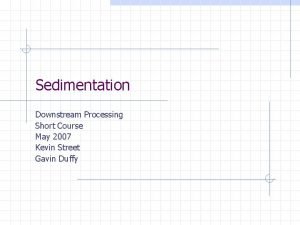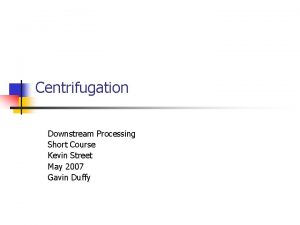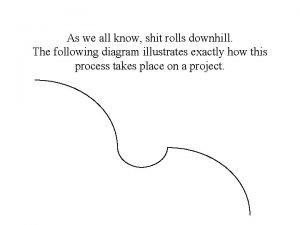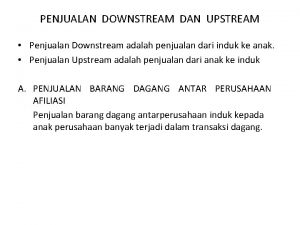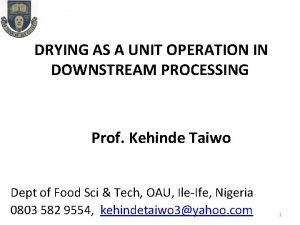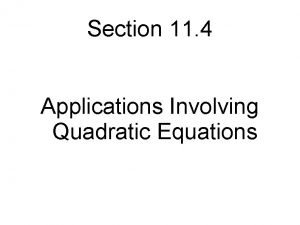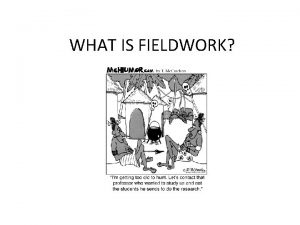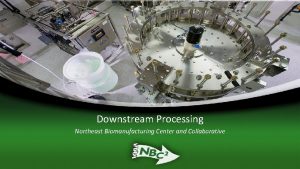FIELDWORK INVESTIGATION PAPER 2 DOWNSTREAM CHANGES IN A















- Slides: 15

FIELDWORK INVESTIGATION PAPER 2 DOWNSTREAM CHANGES IN A RIVER WAITHE BECK LINCOLNSHIRE

CHANNEL CROSS SECTION AREA THIS IS THE AREA OF A SLICE OF THE RIVER CHANNEL AT ANY ONE SITE. IT IS CALCULATED BY MEASURING THE WIDTH OF THE RIVER AND MULTIPLYING THAT BY THE AVERAGE DEPTH OF THE RIVER IT IS STATED IN METRES SQUARED ( m² )

HOW WILL THE CROSS SECTION AREA CHANGE IN A DOWNSTREAM DIRECTION THE CROSS SECTION AREA WILL INCREASE IN A DOWNSTREAM DIRECTION, THE CHANNEL WILL BECOME WIDER AND DEEPER TO COPE WITH THE INCREASE IN THE VOLUME (DISCHARGE) OF WATER FLOWING IN THE RIVER DOWNSTREAM

AVERAGE VELOCITY THIS IS THE AVERAGE SPEED OF THE RIVER FLOWING IN A DOWNSTREAM DIRECTION MEASURED IN METRES PER SECOND ( m/sec) The average velocity is quite tricky to calculate as velocity varies depending where in the cross you measure it due to friction with the bed and banks

HOW DOES RIVER VELOCITY CHANGE IN A DOWNSTREAM DIRECTION Average velocity increases in a downstream direction. This is surprising since the gradient reduces nearer the mouth of the river and you would expect velocity to decrease. However, the channel becomes larger and a more efficient shape, as well as the bed becoming smoother. These factors offset the decrease in gradient / gravity. Mannings equation illustrates this: -

AVERAGE VELOCITY IS MEASURED USING A FLOATING OBJECT (USUALLY AN ORANGE) TIMED OVER A SET DISTANCE, OR BY USING A FLOW METER.

DISCHARGE This is the amount or volume of water flowing past any one point. it is measured in cubic metres per second, m³ / sec, cumecs To calciulate the discharge we times the cross section area ( m² ) by the average velocity ( m / sec )

HOW DOES DISCHARGE CHANGE IN A DOWNSTREAM DIRECTION Discharge will increase in a downstream direction as the size of the drainage basin supplying water increases and tributaries bring more water to the main river

HYDRAULIC RADIUS : CHANNEL EFFICIENCY This is calculated by dividing the channel cross section area by the wetted perimeter A larger hydraulic radius means a more efficient channel and less friction on the flow of water since the wetted perimeter will be relatively small

BEDLOAD SIZE Bedload size is measured by taking a random sample of gravel from the river bed and measuring the long axis Long axis is axis A How will you measure it?

WHAT WILL HAPPEN TO BEDLOAD SIZE IN A DOWNSTREAM DIRECTION The bedload long axis will get smaller in a downstream direction as the bedload is eroded by the process of attrition aattrit ion attrition

BEDLOAD SHAPE AND SPHERICITY We use the sample of bedload to assess the shape/roundness/angularity using the Powers scale This is subjective only. The Powers numbers go from 1, very angular to 6 well rounded

HOW WILL BEDLOAD SHAPE / ROUNDNESS CHANGE IN A DOWNSTREAM DIRECTION The bedload will become more spherical and more rounded in a downstream direction as the process of attrition erodes away any sharp edges and ridges

THESE CHANGES ARE ILLUSTRATED BY THE BRADSHAW MODEL This is our background theory

NOW FORMULATE REASONED HYPOTHESES TO SHOW AND WHY EACH OF THE FOLLOWING SHOULD CHANGE IN A DOWNSTREAM DIRECTION CROSS SECTION AREA AVERAGE VELOCITY DISCHARGE HYDRAULIC RADIUS / CHANNEL EFFICIENCY BEDLOAD SIZE BEDLOAD SHAPE / ROUNDNESS
 What is physical change and chemical change
What is physical change and chemical change Elizabeth mulroney
Elizabeth mulroney A boat traveled 336 miles downstream and back
A boat traveled 336 miles downstream and back Sedimentation in downstream processing
Sedimentation in downstream processing Downstream centrifuge
Downstream centrifuge Cave of unreported exceptions
Cave of unreported exceptions Ripp scheme in downstream processing
Ripp scheme in downstream processing Contoh penjualan downstream dan upstream
Contoh penjualan downstream dan upstream What does we all live downstream mean
What does we all live downstream mean Medicare parts c and d general compliance training answers
Medicare parts c and d general compliance training answers Order promising module of supply chain management
Order promising module of supply chain management Drying in downstream processing
Drying in downstream processing Distribution channel system
Distribution channel system Quadratic equation upstream and downstream
Quadratic equation upstream and downstream Downstream entity examples
Downstream entity examples Supply chain upstream and downstream
Supply chain upstream and downstream



